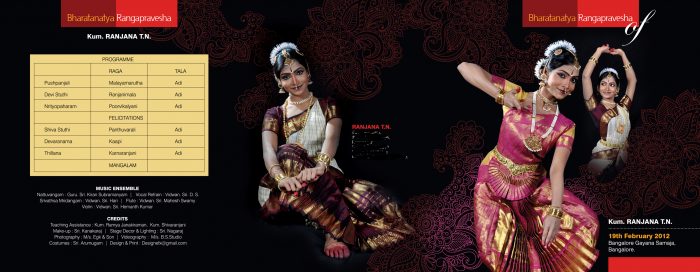As a little girl, I didn’t make any secret of my love for dance. My mother tells me that I would dance just about anywhere – in front of the TV as my favourite Bollywood songs played, on the road while walking, or as we traveled in an auto-rickshaw. For a skinny kid, I was quite full of energy. Some of my favourite songs to dance to were Chura ke dil mera, Yeh kali kali ankhein, and O Yara dil lagana. I still love those songs and think Shilpa Shetty totally rocked that cheetah printed dress in Chura ke dil mera.
When I was 5, my mother decided to enroll me in a local Bharatanatyam dance class when she noticed my craze for dance and the fact that I barely ate anything for a kid my age. Her thought process was that the dance classes would make me feel hungry and want to eat more. Smart woman. To no one’s surprise, I took to Bharatanatyam from the get-go. My teacher was this beautiful eyed woman who exuded grace and proficiency. I immediately decided that I wanted to dance like her! I attended classes twice a week and showed off what I learnt in class to my family every day. And thus began my love affair with Bharatanatyam.
Bharatanatyam is a south Indian art form that originated about 2000 years ago from the state of Tamil Nadu. Rukmini Devi Arundale made it mainstream in 1935. Prior to that, Bharatanatyam was called Sadhir and considered a vulgar art form. Rukmini Devi thought otherwise. She thought it to be a mesmerizing, beautiful, and godly art form and decided to learn it herself. She gave a public performance in 1935 and christened it Bharatanatyam or the dance of India. She then went on to set up the Kalakshetra Foundation in Adayar, Chennai which became the foremost institutions to learn the dance form. Bharatanatyam has its foundations in Natya Shastra which is a Sanskrit treatise on the performing arts. Its a dance-drama meaning that there is a combination of pure movements and enactment of a story.
I learnt the art form for more than 20 years. In 2012, I gave what’s called Rangapravesham or Arangetram. It is a sort of ‘coming of age’ performance which a dancer gives to showcase to the world that she’s trained for years and gained proficiency enough in the art form to perform on stage. It’s a 3-4 hour solo performance and the most important performance in a dancer’s life. For a dancer, it’s as significant as, say, getting married. I mean, when you invite nearly one thousand people, make preparations for months, and spend quite a lot of money on the event, you know it’s a big affair! This is what my invitation looked like. It makes me so excited to see it even now. I can’t help but share it here. 😀

When you learn something from that young an age and for that long a time, it leaves an indelible impression on you. It gets into your very DNA and sculpts the core of who you are, for better or worse. I’d like to think it’s for the better, though. I feel gratitude for having learnt this dance form and can see its imprint in everything I am. Here is how Bharatanatyam impacted me:
- It made me disciplined. This art form, like other traditional forms, is regimented and needs dedication, focus, and persistence. The years and years of practice (not to mention classes at 6:30 am) and relentlessly perfecting every piece learnt forces you to develop discipline.
- I am an empathetic person and attribute this to my dance training. Bharatanatyam needs you to step into the character you’re portraying and feel the emotions they’re feeling. I don’t think I would have been able to experience that vast a range of emotions with that intensity if not for the wide variety of songs I danced to. Being Lord Krishna and switching character to Arjuna on the battleground of Kurukshetra can be an intense experience. Btw, my favourite song is called Jagadodharana composed by the Carnatic poet Purandaradasa in the 1500s which depicts the dynamic between Krishna as a mischievous little boy and his mother Yashodha. It’s so endearing that it brings tears to my eyes even today.
- It made me fall in love with physical movement and made it an integral part of my life. That holds me in good stead even today.
- I understood the Hindu mythology and scriptures in a detailed and visceral way. I don’t think I’d have understood the Bhagavad Geeta, the Mahabharata, or stories of Shiva, Parvati, and the numerous gods in Hinduism as well if not for Bharatanatyam.
- It taught me humility. In all traditional Indian art forms, the teacher or the guru is revered like God and the students are taught that to learn, one must stay humble. Of course, this can become a double-edged sword and lead to becoming subservient to the teacher which can be disempowering. Overall, though, I think that my learning curve was a fast one because of this mindset, especially in the early years.
So…that was my dance journey! It felt good to share it here. I’d like to end this post with a quote from Rukmini Devi Arundale. Because it makes sense to me and she’s one of my idols. 🙂
A great dancer’s art must depend first on the life he or she expresses, secondly upon the beauty of technique and lastly only, upon its arrangement, costume, and presentation…. Though form, technique, and skill are essential, great Art must have the impetus of genius, and inspiration. Then there is permanency.
Source: https://quotepark.com/authors/rukmini-devi-arundale/
PS: Thank you, Karin Taliga, for inspiring me to write this post!